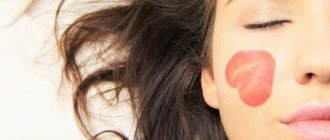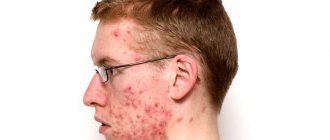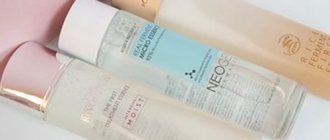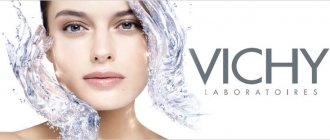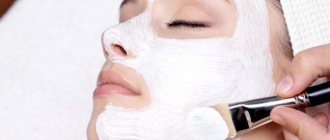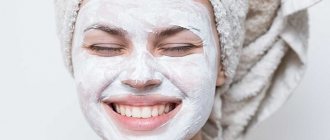Peeling is a very serious and quite traumatic procedure for the skin, but it helps to get rid of many problems. After exfoliation, you need to carefully monitor the condition of your face to achieve the best result. How to take care of your face after peeling so as not to be disappointed?
- Why take care of your face after peeling?
- How to care for your skin after peeling
- How to care for your skin after a chemical peel
- Facial care after acid peeling
- Jessner Peel
- Retinoic (yellow) peeling
- TCA peeling
- Almond peeling
- Laser peeling
- Coral peeling
Why take care of your face after peeling?
Not everyone realizes the danger an ordinary cosmetic procedure can pose to the skin. Objectives of the post-peeling care complex:
- reducing stress on the skin;
- reduction of the rehabilitation period;
- moisturizing damaged skin;
- enhancing epidermal regeneration;
- restoration of the natural immune barrier;
- reducing the body's reaction, minimizing the consequences.
If you do not have the opportunity to care for your skin after the procedure, then it is better not to do it at all. Because without care, at best, nothing will change, but more often the skin condition becomes much worse than it was before peeling. Many adverse reactions are caused by insufficient care.
Reasons for possible consequences
Consequences may or may not be acceptable. Acceptable ones arise almost always and in everyone due to invasive manipulations as a reaction to chemical or mechanical stress.
Unacceptable consequences primarily arise due to the low professionalism of the cosmetologist, violation of aseptic and antiseptic rules by the client, incorrect facial cleansing technique, etc.
The possibility of dangerous consequences also depends on the correct determination of facial skin characteristics.
How to care for your skin after peeling
After exfoliation, the body takes a lot of energy to recover. Before any peeling, the skin must be prepared. The preparatory stage includes:
- Daily skin care. Before the procedure, it is necessary to train the sebaceous glands so that they do not react too strongly to the aggressive effects of peeling. If the skin is not prepared, the risk of papules and acne will significantly increase, even after superficial exfoliation. Two weeks before the intended visit to the salon, the skin can be treated once a day with lemon juice or sour fruits.
- General support for the body. Peeling always damages the skin. The body spends a lot of effort and energy on its restoration. In order to support it, you need to take a course of vitamin and mineral complexes and eat right. It is advisable to give up all bad habits a month before the planned procedure.
Benefits of the procedure
It is very important to cleanse your facial skin regularly. Peeling helps to do this more thoroughly, which has a beneficial effect on the skin as a whole. So, thanks to the procedure:
- Stimulating the metabolic process in epidermal cells.
- Normalizing the functioning of the sebaceous glands.
- Elimination of excess oiliness or dryness of the skin.
- Smoothing the relief.
- Correction of scars, scars and post-acne.
- Evens out skin tone, fights pigmentation and freckles.
- Giving the skin unprecedented elasticity and tightening.
- Comprehensive skin health, reducing the risk of acne.
Cleaning is an excellent prevention of early aging processes, sagging tissues and the appearance of deep wrinkles.
Facial care after acid peeling
Depending on the depth, acid peeling can be very difficult to tolerate and can even be extremely painful. The most non-traumatic type is peeling with fruit acids. They gently exfoliate dead skin without causing excessive inflammation.
After exfoliation with fruit acids, you can return to your daily lifestyle in 1-2 days. After the recovery period, you can immediately use decorative cosmetics.
Despite the fact that it is very gentle, the skin requires “mechanical” rest, that is, under no circumstances should you remove particles of the epithelium or scratch it. After the peeling is carefully washed off, you can apply a light, not very greasy cream with regenerating properties (A-Derma is great).
Jessner Peel
This is one of the strongest types of medium peeling. After it, recovery lasts 5-6 days. During this entire time, you will not be able to use decorative cosmetics (maximum - touch up your eyes and lips), so it is better to spend these few days at home.
You can only wash your face with warm boiled water; soap can only be used after 2-3 days. The most suitable and inexpensive restoration cream is Bepanthenol. It has a regenerating and calming effect, relieves inflammation. For the first 14 days, it is prohibited to use products containing any acids.
Retinoic (yellow) peeling
It cannot be confused with any other type of peeling due to the characteristic yellowish tint on the skin. How to care for your face after yellow peeling? It differs in that the skin does not peel off in patches afterwards. Despite this, you do not need to use any scrubs to exfoliate small scales.
TCA peeling
TCA stands for trichloroacetic acid. In addition to local skin care therapy, it is necessary to take vitamin and mineral complexes containing zinc. However, ointments with zinc, copper and ceramides are also welcome. Some experts recommend washing your face with acidified water after a TCA peel. Effect of washing with vinegar water:
- acts as an antiseptic;
- gently stimulates exfoliation;
- prevention of “wetting” due to the drying effect.
Almond peeling
To relieve any unpleasant sensations, you can brew yourself some chamomile and wash your skin with it. It has a neutralizing effect on the skin. After 2-3 days, you can prepare the following soothing masks at home:
- Honey. To prepare it, you should mix a tablespoon of milk, a few drops of Aloe Vera juice, chicken yolk and a tablespoon of honey (it is better to choose thick honey; liquid honey will not give the mask the desired consistency).
- Oatmeal. Simply add a teaspoon of oatmeal to honey.
Also, the body will be greatly supported by antioxidant therapy (you can take vitamin C and E), because even mild and gentle peeling is a burn and a violation of the natural immune barrier. Damaged skin is a gateway for any infection.
Deep types of peeling require special attention. They can be compared to a surgical operation. Real deep peelings are not performed in the Russian Federation. They are carried out in a hospital setting under the supervision of specialists. After the procedure, a course of antibiotics will be required to avoid infection in the damaged areas.
You can’t even wash your face for several days after deep exfoliation. Such a strong peeling can be performed only once in a lifetime, and after it you will no longer be able to stay in the sun uncontrollably. And the period of application of sunscreen, depending on the specifics of the procedure, can be from 6 months (in some cases it will never be possible to go out into the sun without a cream with SPF effect).
Red spots
If the redness after peeling does not decrease, but gets worse every day, then you should not hesitate to contact a dermatologist. The reasons why the skin becomes irritated are most often the following factors:
- Prolonged erythema. This diagnosis is made if, after peeling, the face remains abnormally red, while the body temperature rises, dizziness begins, and vomiting occurs. A pathological condition is observed if the patient is prone to rosacea (impaired blood circulation due to capillary fragility), as well as after highly concentrated glycolic peeling and other types of deep cleansing. Severe erythema may not subside for several months.
- Dermatitis accompanied by redness and the appearance of pimples. The pathological condition is accompanied by irritation, the skin itches, red spots appear on it, and the patient’s body temperature rises. Even a person who has never had acne before can experience post-procedure dermatitis. Most often, the pathological condition is the result of a Jessner peel. You should not scratch your face or squeeze out inflamed spots: they will disappear on their own, and even faster than simple pimples.
- Red pigmentation. We are talking about the appearance of many red spots on the face. Often such a problem is a signal that the patient who underwent cleansing has pathologies of the liver, gallbladder or digestive tract. To get rid of red spots after peeling, you need to treat the underlying disease. The problem may be due to exposure to harsh retinoic acid in the yellow peel. Also, red spots that appear after peeling are a consequence of the influence of ultraviolet radiation and the use of certain medications.
Sometimes, after intensive cleansing, the reddened face becomes covered with fluid-filled blisters. They signal an incorrect procedure. Most likely, the concentration of the active substance in the drug used was too high, which caused a chemical burn.
Only a dermatologist can cope with this problem. You cannot treat burned skin on your own, as scars and age spots may occur.
Laser peeling
Laser peeling is one of the most effective ways to get the desired result. You can find many before and after photos on the Internet, but few people mention that the difference between them is at least a month.
To achieve the final result, you need to carefully care for your skin while it goes through all stages of recovery. Features of the post-peeling period after using a laser:
- Immediately after the procedure, the skin becomes reddish in color with bright spots (locations of laser exposure). The overall temperature of the skin increases, and spots may form in areas of hyperpigmentation. Redness can persist for a month. By the end of the rehabilitation period, it will not be as pronounced, but it will not be possible without decorative cosmetics.
- The appearance of severe swelling, which only increases during the first day. The area around the eyes and the lower part of the chin are especially affected; the face becomes more “overweight”. After the second day, the swelling begins to gradually go away. This takes up to 3-4 days.
- If scabs form after the procedure, they must be carefully softened and carefully removed. This is a very important stage, since improper exposure can lead to the formation of scars and scars.
- Depending on the depth of impact, the rehabilitation period can last from 2 to 8 weeks.
During the recovery period, physiotherapeutic procedures, medications and care products are used for the skin. For purulent inflammation, you can undergo a course of mechanical cleaning. To stimulate regeneration, laser is ideally combined with biorevitalization. If hyperpigmentation becomes visible, then the use of skin whitening products will be justified.
Basic nuances of skin care after laser peeling:
- Special dressings. For deep types of grinding, meshes with Vaseline are made, but if the impact was not so strong, then you can use ordinary sterile bandages, which should be applied to the treated wound surface for the first few days.
- Using cold compresses. It is carried out during the period of swelling, that is, it needs to be done for the first few days to reduce tissue swelling. You need to apply ice for 20 minutes before going to bed in dangerous areas: eyelids and lower jaw.
- The most important step: softening the resulting crusts using a vinegar solution. A teaspoon of white vinegar is diluted in a glass of boiled water. At the pharmacy you need to purchase several packs of sterile gauze wipes. A napkin soaked in vinegar is applied to problem areas until it heats up and the crusts gently fall off. After this manipulation, the skin should calm down and stop hurting.
- After the procedure, the skin should be treated daily with chlorhexidine.
- In most cases, antibiotics are prescribed to prevent the formation of a purulent-inflammatory process.
- If the skin hurts too much, you can use mild painkillers and anti-inflammatory drugs that are freely available in pharmacies (ibuprofen).
- Ordinary care creams will not work; they need to be replaced with Vaseline or Bepanthen.
- When sleeping, it is better to be in the “on your back” position so as not to accidentally injure the skin of your face.
Coral peeling
Coral peeling is one of the types of mechanical skin exfoliation. Aftercare may differ slightly from chemical peeling or hardware peeling. How to care for your skin after coral peeling? Despite the fact that this variety is quite gentle, there is a danger of developing hyperpigmentation, so it is better to postpone all coral resurfacing until the autumn-winter period and stock up on sunscreen.
You should also not visit baths and saunas to avoid steaming your skin. Every day you need to treat your skin with a vinegar solution (one tablespoon of 9% vinegar per liter of water). During peeling, treatment should be stopped. The skin requires careful hydration throughout the entire period.
Conclusion
Skin care is the most important stage of peeling, because it helps to achieve maximum results and get rid of the negative consequences of the procedure.
How to care for your facial skin after peeling depends on the type of procedure chosen. The deeper the impact, the more complex and multi-stage the care.
Unacceptable consequences
You should only worry and sound the alarm if the following defects are observed on your face:
- An allergic reaction, which is manifested by itching, severe swelling and multiple rashes.
- Persistent and prolonged erythema. This is most often encountered by people suffering from rosacea. This type of redness can be observed on the face for about 1 year. Therefore, it is necessary to reduce physical activity, avoid visiting a bathhouse or sauna, as well as avoid alcohol, spicy and spicy foods.
- Herpes on the face. You need to start fighting it immediately after you discover it. To do this, use medications with an antiviral effect.
- Marble dermis effect. It may appear after deep cleansing of the face due to massive destruction of melanocytes. It is impossible to completely eliminate the shade of marble; only correction is possible.
- A clearly defined dividing line. Women with dark skin types may face this problem. The only way to get rid of the demarcation boundary is through superficial cleaning.
- Multiple acne. To eliminate them, you need to use vitamin complexes and antibiotics.
- Scars of hypertrophic and keloid types. Their appearance depends on the characteristics of the patient’s body and skin. This problem can only be solved surgically, using laser resurfacing, etc.
Severe swelling and itching
These symptoms of an allergic reaction are very dangerous for the body, especially swelling. Most patients experience an itchy face after a harsh peel. It is possible that this procedure is not suitable for your skin, so you should no longer resort to it.
The situation with swelling is much more dangerous, because in some cases angioedema may appear. If you do not seek medical help in time, death is likely.
If the face is not very swollen, it is enough to use antihistamines. If you experience heavy breathing, pronounced and unbearable itching, emergency treatment is urgently needed.
Is it possible to peel off the skin?
Many women try to tear off the skin as quickly as possible after the peeling procedure. Why should you never rip off the dermis? In this case, you can disrupt the regeneration process of the skin and its cells. To make peeling go away faster, follow your cosmetologist’s recommendations for skin care.
How to deal with complications and side effects?
Exfoliation of the skin can cause scarring, acne, and pigmentation. An exacerbation of herpes is also possible.
Pigmentation is a side effect after peeling. To prevent this, the face is treated with kojic and retinoic acid before the procedure. Some manipulations after this procedure are also carried out to remove pigmentation. This is the treatment of facial skin with acetylcysteine and products with pronounced antioxidant properties.
Herpes can worsen in those people who report its occurrence at least twice a year. To prevent herpes from spreading after the procedure, therapy is necessary. For this purpose, local agents and systemic antiviral drugs are used.
If acne occurs quite often, then after peeling the situation will worsen. Therefore, it is necessary to use anti-inflammatory and sebostatic agents.
Severe peeling may occur after medium or deep peels. There is no way to prevent this. You should not try to speed up the exfoliation of the skin, as this can cause scarring.
If the cosmetologist follows the rules of the procedure and uses high-quality products, complications rarely arise.
Recommendations from cosmetologists
- Is it possible to apply foundation after peeling? - No you can not. This risks skin infection. In addition, the foundation will not cover up severe peeling, but, on the contrary, will emphasize them even more.
- How to quickly remove facial redness? – For 1.5 – 2 weeks you should give up spicy and fatty foods, alcohol consumption, sports activities and visiting the sauna. These actions dilate the blood vessels, so the redness goes away much more slowly.
- Is it possible to remove peeling on your own? – Under no circumstances should you solve the problem of facial peeling on your own. Additional abrasives to speed up the renewal process are prohibited. They can penetrate into the deep layers of the skin, causing scars that will be very difficult to remove.
- If you have the slightest suspicion of complications, you must immediately make an appointment with a cosmetologist. There is no need to wait for the problem to go away on its own. It often happens that a complication goes into a chronic stage without timely intervention.



